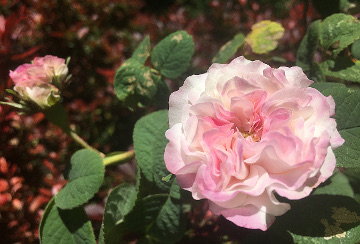
Propagation

The preferred way to propagate roses is through cuttings.
Take a six-inch green cane with at least 5 leaves, bruise or split the end, dip it in honey or rooting hormone, then plant it in a pot.
To maintain even moisture, cover it with a glass jar; otherwise, mist it daily to prevent it from drying out.
Be patient. Roses root in their own time, some as soon as a week, some as late as three months. The presence of fresh growth confirms that the cutting has successfully rooted.
Roses do propagate by seed. New rose breeds are created through this method, which requires patience and expertise.
If you want to try this method, you need to chill the rose hips in the refrigerator, like you would bulbs, to mimic them overwintering in the garden, otherwise their seeds won't germinate.
Ramblers, rugosas, and landscaping roses tend to produce suckers, which are long side roots that give rise to new canes, at a distance from the main plant. Remove the section of root with the new cane from the main shrub and transplant it where desired.

Pruning

First, not all roses need pruning; floribundas, rugosas, and old roses, bloom on old wood, and removing their canes will all but guarantee they won't bloom.
Only prune those for the purpose of removing dead or damaged canes, shaping, or enhancing air circulation.
Hybrid tea roses, chinas, and landscaping roses thrive with aggressive pruning. Cut them down to one-third of their size and leave just three or four canes per shrub, with ample spacing.
Ramblers enjoy spreading out, so regular trimming is necessary to control their growth.
If climbing roses grow too far away from their supports, their canes can be trimmed back or trained on them, but otherwise, leave them be.
In general, it's best to refrain from pruning a rose if you're unsure about it. Roses have survived on their own for longer than they have been cultivated by gardeners. They'll be just fine.
